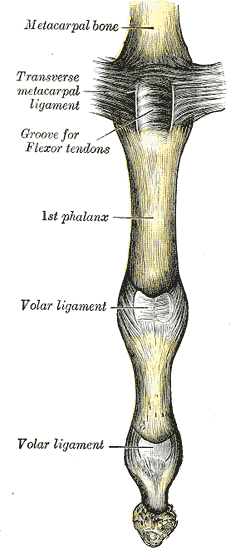Deep transverse metacarpal ligament
Deep transverse metacarpal ligament
The deep transverse metacarpal ligament is a crucial structure in the human hand, playing a significant role in maintaining the stability and alignment of the metacarpal bones. This ligament is a strong, fibrous band that connects the heads of the second to fifth metacarpal bones, preventing them from spreading apart excessively.
Anatomy[edit | edit source]
The deep transverse metacarpal ligament is located in the palm of the hand. It spans across the heads of the second, third, fourth, and fifth metacarpal bones, binding them together. This ligament is situated deep to the flexor tendons and the palmar aponeurosis, and it is closely associated with the lumbrical muscles and the interosseous muscles.
Function[edit | edit source]
The primary function of the deep transverse metacarpal ligament is to maintain the transverse stability of the metacarpal bones. By connecting the heads of these bones, the ligament helps to ensure that the metacarpophalangeal joints (MCP joints) remain properly aligned during hand movements. This stability is essential for effective grip and dexterity.
Clinical Significance[edit | edit source]
Injuries to the deep transverse metacarpal ligament can result in instability of the metacarpal bones, leading to difficulties in hand function. Such injuries may occur due to trauma or overuse. Diagnosis of ligament injuries typically involves physical examination and imaging studies such as X-ray or MRI.
Related Structures[edit | edit source]
The deep transverse metacarpal ligament works in conjunction with other structures in the hand, including:
- Collateral ligaments of the MCP joints
- Palmar ligaments
- Flexor tendons
- Extensor tendons
- Interosseous muscles
- Lumbrical muscles
See Also[edit | edit source]
- Metacarpal bones
- Metacarpophalangeal joint
- Flexor tendons
- Palmar aponeurosis
- Lumbrical muscles
- Interosseous muscles
References[edit | edit source]
External Links[edit | edit source]
Search WikiMD
Ad.Tired of being Overweight? Try W8MD's physician weight loss program.
Semaglutide (Ozempic / Wegovy and Tirzepatide (Mounjaro / Zepbound) available.
Advertise on WikiMD
|
WikiMD's Wellness Encyclopedia |
| Let Food Be Thy Medicine Medicine Thy Food - Hippocrates |
Translate this page: - East Asian
中文,
日本,
한국어,
South Asian
हिन्दी,
தமிழ்,
తెలుగు,
Urdu,
ಕನ್ನಡ,
Southeast Asian
Indonesian,
Vietnamese,
Thai,
မြန်မာဘာသာ,
বাংলা
European
español,
Deutsch,
français,
Greek,
português do Brasil,
polski,
română,
русский,
Nederlands,
norsk,
svenska,
suomi,
Italian
Middle Eastern & African
عربى,
Turkish,
Persian,
Hebrew,
Afrikaans,
isiZulu,
Kiswahili,
Other
Bulgarian,
Hungarian,
Czech,
Swedish,
മലയാളം,
मराठी,
ਪੰਜਾਬੀ,
ગુજરાતી,
Portuguese,
Ukrainian
Medical Disclaimer: WikiMD is not a substitute for professional medical advice. The information on WikiMD is provided as an information resource only, may be incorrect, outdated or misleading, and is not to be used or relied on for any diagnostic or treatment purposes. Please consult your health care provider before making any healthcare decisions or for guidance about a specific medical condition. WikiMD expressly disclaims responsibility, and shall have no liability, for any damages, loss, injury, or liability whatsoever suffered as a result of your reliance on the information contained in this site. By visiting this site you agree to the foregoing terms and conditions, which may from time to time be changed or supplemented by WikiMD. If you do not agree to the foregoing terms and conditions, you should not enter or use this site. See full disclaimer.
Credits:Most images are courtesy of Wikimedia commons, and templates, categories Wikipedia, licensed under CC BY SA or similar.
Contributors: Prab R. Tumpati, MD

